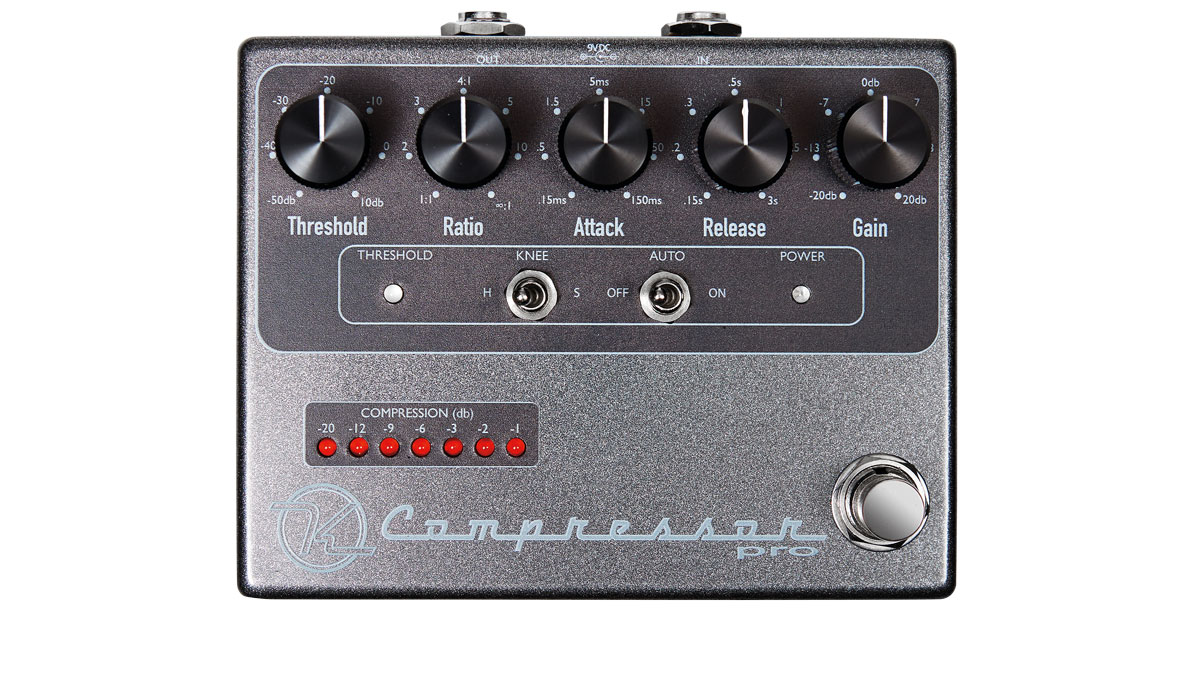MusicRadar Verdict
A versatile compressor offering not just plenty of options for sculpting guitar and bass sounds, but also many practical applications in the studio.
Pros
- +
Lots of compression control. Can handle any guitar compression tasks. Practical in the studio, too.
Cons
- -
Expensive. A little complex for those used to guitar comps.
MusicRadar's got your back
If there's one Keeley pedal that has captured the imagination of musicians, it's the Keeley compressor, itself based on modifications to the classic MXR Dyna Comp/Ross grey compressor circuitry.
Still available in both two-knob and four-knob versions, the Compressor now has a sibling in the shape of the Compressor Pro, a larger pedal with a lot of control, designed not just for guitar but to accept a range of input signals for studio work.
"There's a green LED that lights up red when your guitar signal exceeds the threshold that you set with the first knob"
The pedal's top panel is laid out like a studio compressor with a set of knobs taking care of Threshold, Ratio, Attack, Release and Output Gain. You can also select hard or soft Knee operation to set whether the compression comes in hard at the set threshold or eases in more gently.
There's also an auto mode that takes away the responsibility of setting the Attack and Release knobs, instead adjusting the envelope automatically and naturally in response to program material - what you are playing.
Setting up for when compression kicks in is easy, because there's a green LED that lights up red when your guitar signal exceeds the threshold that you set with the first knob. The actual amount of gain reduction (compression) going on is likewise shown on a seven-segment LED ladder.
While the knob array may seem overly complicated to anyone more familiar with a typical two-knob guitar compressor, it's fairly straightforward - the Ratio knob sets how strong the compression will be once your signal exceeds the threshold, and the Attack and Release knobs can shape your note to make it snap (if desired) and adjust any added sustain.
The Gain knob sets the output and can be used as a boost (with a ratio of 1:1 dialled in you get no compression and can use the pedal as a pure booster).
Overall, this is a compressor that will take care of all typical guitar compressor tasks - level consistency, sustain, chicken picking note definition and so on - whether you are looking for transparent subtlety or an obvious effect.
If you want underfoot onstage simplicity, you may be better off with a two-knob compressor, but with the Pro you get a versatile compressor offering not just plenty of options in sculpting guitar and bass sounds, but also many practical applications in the studio.
Trevor Curwen has played guitar for several decades – he's also mimed it on the UK's Top of the Pops. Much of his working life, though, has been spent behind the mixing desk, during which time he has built up a solid collection of the guitars, amps and pedals needed to cover just about any studio session. He writes pedal reviews for Guitarist and has contributed to Total Guitar, MusicRadar and Future Music among others.
"This is the amp that defined what electric guitar sounds like": Universal Audio releases its UAFX Woodrow '55 pedal as a plugin, putting an "American classic" in your DAW
"Yamaha has achieved an extraordinary level of immersiveness and realism, crafting an instrument that sounds closer to an acoustic piano and feels like one under your fingers": Yamaha Clavinova CLP-885 digital piano review
With its latest free update, Ableton has finally turned Note into the app I always wanted it to be











